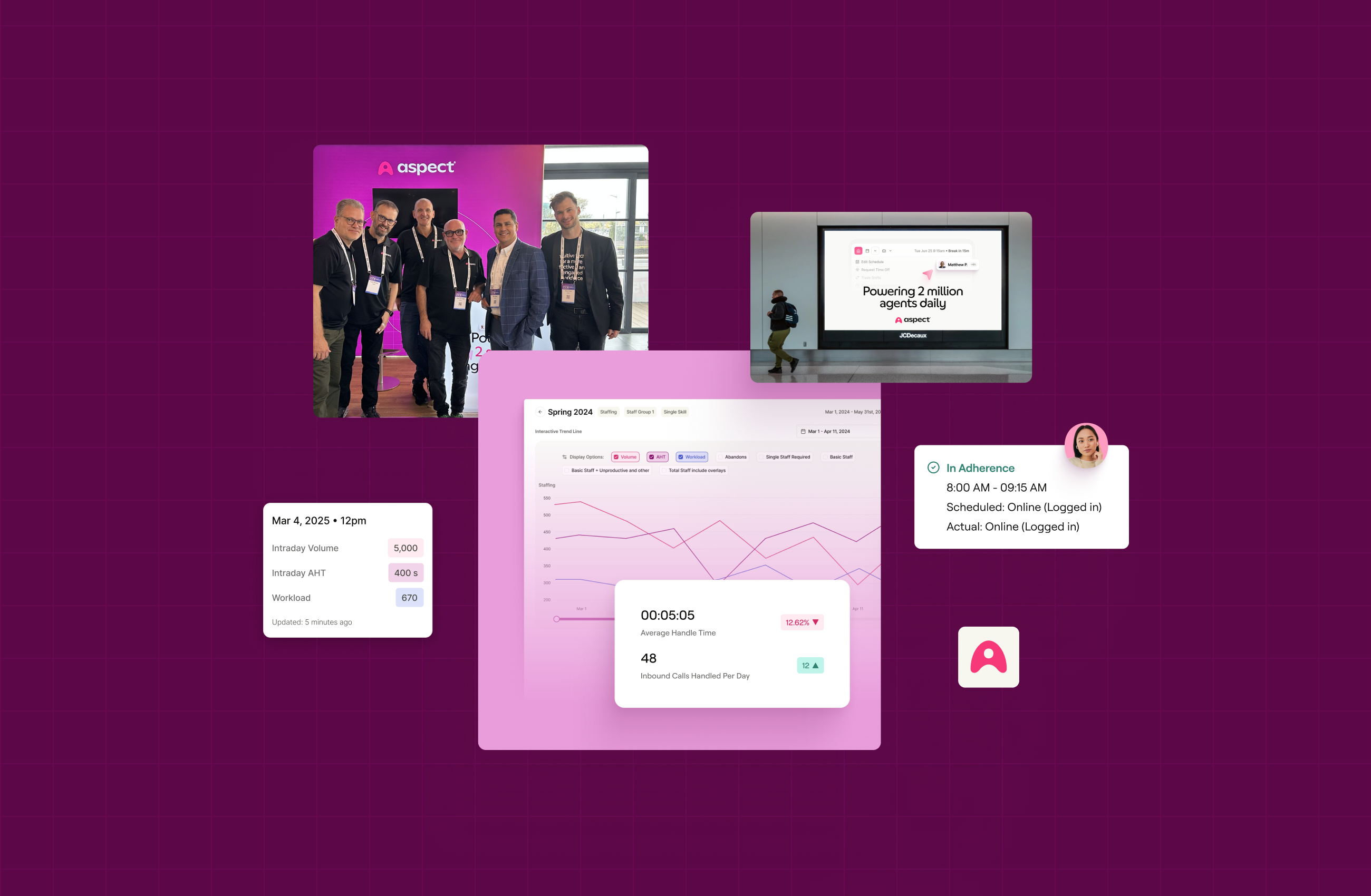The world of workforce technology has changed exponentially over the decades, starting with workforce management in the 1980s to improve contact center operations. Today, organizations have growing needs that require new approaches to workforce management.
In this blog, we'll explore the key differences between workforce management (WFM), workforce optimization (WFO), and workforce engagement management (WEM), as well as examine the emerging concept of proactive Workforce Intelligence.
Workforce management (WFM): The foundation
Workforce management is the practice of ensuring a business has the right number of employees, at the right time, at the right cost. This includes capabilities like workforce forecasting, scheduling, and time management to ensure smooth, efficient operations.
WFM enhances operational efficiency and controls labor costs through accurate contact center volume forecasting, proper staff scheduling, and tracking employee schedule adherence.
As workforce needs evolved and technology improved, many contact centers using separate workforce management software and quality management solutions demanded more integrated approaches. This led to the next stage: workforce optimization.
Workforce optimization (WFO): The broader approach
Workforce optimization developed in the early to mid-2000s as a more integrated approach to managing a workforce. WFO combines workforce management, quality management, and performance management solutions to create a comprehensive technology suite.
With WFO, businesses can optimize performance through integrated technology and analytics provided by quality and performance solutions, which helps inform better decision-making. With effective workforce optimization, businesses enhance operations, improve service quality, boost employee performance, and ultimately reduce costs.
However, many contact centers continued to see high attrition rates due to poor employee experiences. High turnover can ultimately lead to poor customer experiences and impact an organization's bottom line. This created a new evolution of workforce solutions focused on centering the employee experience.
Workforce engagement management (WEM): The employee-centered evolution
Workforce engagement management emerged in the 2010s as a foundational shift toward focusing on employee experience and satisfaction. The primary principle of WEM centers on employee experience being the key to better organizational performance. In short: happy employees make for better business.
WEM takes a holistic approach by combining WFM, WFO, and employee engagement practices. Beyond standard features like scheduling, forecasting, and performance and quality management, WEM incorporates employee engagement programs featuring training and coaching tools, gamification, and feedback systems designed to ensure employee voices are heard.
With effective WEM solutions, organizations can reduce turnover, improve employee satisfaction and retention, and enhance customer experiences.
As work models have changed, technology has evolved, and employee and customer expectations have risen, traditional WEM solutions are no longer meeting organizational needs. We’re stepping into a new era of workforce technology, powered by AI and fueling higher human potential.
Workforce Intelligence: The next frontier
Workforce Intelligence represents the next evolution in workforce technology, powered by AI-driven analytics that deliver both predictive and proactive insights. This approach leverages technologies including machine learning, natural language processing, and predictive analytics to transform contact center operations.
Rather than relying on reactive technology, organizations can make proactive decisions with predictive insights that inform the best choices, adapting to rapidly changing business needs. With adaptive frameworks for continuous improvement across organizations, businesses can stay ahead of the curve.
The need for intelligent workforce technology
As we've explored the evolution from WFM to WFO to WEM and now to Workforce Intelligence, it's clear that organizations must consider technological adoption to stay competitive in today's rapidly changing business environment.
However, the future of workforce technology isn't just about adopting new tools, it's about transforming how organizations approach workforce management and employee engagement. The shift towards Workforce Intelligence gives organizations the opportunity to:
- Anticipate challenges before they arise: Rather than implementing reactive solutions, organizations can identify potential issues and address them proactively.
- Personalize the employee experience: Advanced algorithms can analyze employee preferences, skills, and areas for development to create tailored experiences that boost satisfaction, engagement, and retention.
- Adapt in real-time: Intelligent systems can automatically adjust forecasts, schedules, and resource allocation as business conditions change, ensuring optimized performance at any given time.
Advanced workforce technology elevates human potential by automating routine tasks and providing proactive insights. This frees supervisors and managers to focus on strategic initiatives while allowing employees to dedicate more time to meaningful and complex customer interactions.
For forward-thinking organizations, the question isn't whether they need to adopt more intelligent platforms in the future. Instead, it's how quickly this technology can be implemented to gain a competitive edge in an increasingly competitive landscape.
Learn more about how Aspect is building for Workforce Intelligence and the future of workforce technology.









